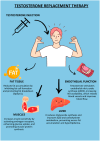Effects of Testosterone Replacement Therapy on Metabolic Syndrome in Male Patients-Systematic Review
- PMID: 39596286
- PMCID: PMC11594927
- DOI: 10.3390/ijms252212221
Effects of Testosterone Replacement Therapy on Metabolic Syndrome in Male Patients-Systematic Review
Abstract
Metabolic syndrome (MS) comprises several symptoms or disorders that significantly increase the risk of developing atherosclerosis and type 2 diabetes. This study aims to determine the direct impact of testosterone therapy on the components of MS; although excluding type 2 diabetes cases. The authors conducted a systematic literature search of PubMed, Scopus, and Cochrane databases without date limits, using keywords such as "testosterone therapy", "metabolic syndrome" and "men". The studies included in our review focused on the effects of testosterone replacement therapy (TRT) in male patients with MS, yet rejecting individuals where type 2 diabetes constituted the only diagnosis. A meta-analysis was performed using PQStat v1.8.6 software. The overall effect size (mean difference) was calculated using a random effects model. Our meta-analysis indicates that testosterone therapy leads to improvement in the components of MS. Significant reductions were observed in waist circumference (WC) (95% CI: -0.709 to 0.094; p = 0.011), as well as in triglycerides (TG) (95% CI: -0.474 to 0.120; p = 0.039). These findings support the potential therapeutic benefits of testosterone treatment in managing MS. However, further research is vital to explore the long-term effects and the safety of this therapy in patients with metabolic syndrome.
Keywords: male; metabolic syndrome; obesity; testosterone; testosterone therapy.
Conflict of interest statement
The authors declare no conflicts of interest.
Figures









Similar articles
-
Systemic pharmacological treatments for chronic plaque psoriasis: a network meta-analysis.Cochrane Database Syst Rev. 2021 Apr 19;4(4):CD011535. doi: 10.1002/14651858.CD011535.pub4. Cochrane Database Syst Rev. 2021. Update in: Cochrane Database Syst Rev. 2022 May 23;5:CD011535. doi: 10.1002/14651858.CD011535.pub5. PMID: 33871055 Free PMC article. Updated.
-
Psychological therapies for panic disorder with or without agoraphobia in adults: a network meta-analysis.Cochrane Database Syst Rev. 2016 Apr 13;4(4):CD011004. doi: 10.1002/14651858.CD011004.pub2. Cochrane Database Syst Rev. 2016. PMID: 27071857 Free PMC article.
-
Systemic pharmacological treatments for chronic plaque psoriasis: a network meta-analysis.Cochrane Database Syst Rev. 2017 Dec 22;12(12):CD011535. doi: 10.1002/14651858.CD011535.pub2. Cochrane Database Syst Rev. 2017. Update in: Cochrane Database Syst Rev. 2020 Jan 9;1:CD011535. doi: 10.1002/14651858.CD011535.pub3. PMID: 29271481 Free PMC article. Updated.
-
The impact of biological interventions for ulcerative colitis on health-related quality of life.Cochrane Database Syst Rev. 2015 Sep 22;2015(9):CD008655. doi: 10.1002/14651858.CD008655.pub3. Cochrane Database Syst Rev. 2015. PMID: 26393522 Free PMC article.
-
Effects of testosterone on body composition, bone metabolism and serum lipid profile in middle-aged men: a meta-analysis.Clin Endocrinol (Oxf). 2005 Sep;63(3):280-93. doi: 10.1111/j.1365-2265.2005.02339.x. Clin Endocrinol (Oxf). 2005. PMID: 16117815
Cited by
-
Impact of Testosterone on Male Health: A Systematic Review.Cureus. 2025 Apr 24;17(4):e82917. doi: 10.7759/cureus.82917. eCollection 2025 Apr. Cureus. 2025. PMID: 40290556 Free PMC article. Review.
References
-
- Alberti K.G., Zimmet P.Z. Definition, diagnosis and classification of diabetes mellitus and its complications. Part 1: Diagnosis and classification of diabetes mellitus provisional report of a WHO consultation. Diabet. Med. 1998;15:539–553. doi: 10.1002/(SICI)1096-9136(199807)15:7<539::AID-DIA668>3.0.CO;2-S. - DOI - PubMed
Publication types
MeSH terms
Substances
LinkOut - more resources
Full Text Sources
Medical
Miscellaneous

